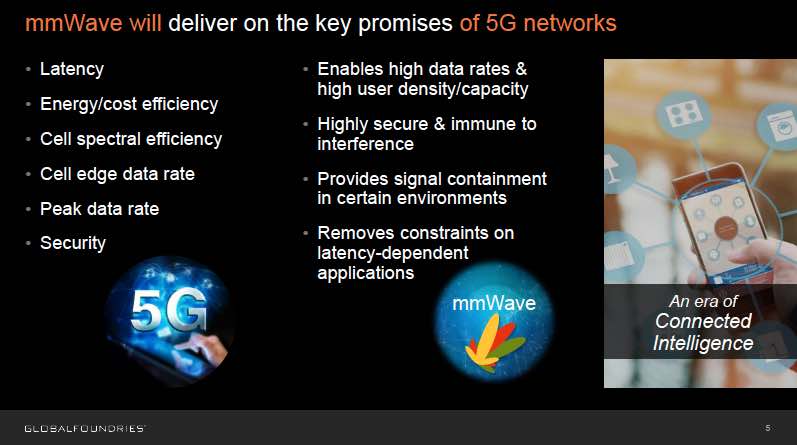5G is in the news again. Sprint has mounted a legal challenge against ATT, claiming that ATT is misleading people into believing that they already are offering 5G. While ATT is about to start testing of 5G, they have also sent out updates that causes customer phones to display 5GE when they are still on 4G LTE systems. The truth is that 5G will be rolling out soon, however it is not just going to be your phone made faster. 5G is a whole new set of ways that devices can communicate. There are three ranges of frequencies that 5G will be using in an integrated fashion.
The low frequency band will be centered around 700MHz, which will propagate well outdoors and will help serve rural areas. The next range of frequencies will be around 2 to 4GHz, and will offer much higher data rates than existing LTE service. At the high end will be frequencies centered around 26 GHz, and 66 to 71 GHz. As you are probably aware, millimeter wavelength (mmWave) frequencies like these do not travel far in the air. This makes them ideal for line of sight transmission in dense urban areas. mmWave frequencies can offer extremely low latency and very high bandwidth.

A big challenge for the semiconductor industry is designing the RF chips needed to build base stations and handsets. It is worth pointing out, though, that 5G will probably also appear in the home as “fixed wireless” internet service. Verizon is already working on this. But, back to mmWave design. I recently had a chance to talk with Peter Rabbeni, GLOBALFOUNDRIES RF Business Unit VP, around the time when he presented on RF EDA for 5G at a DesignCon event sponsored by ANSYS.
One of the important technologies that will make mmWave feasible for handsets is phased array antennas. They will allow focusing the beam so it sends maximum energy toward the desired receiver. Due to propagation loses, omnidirectional signals would require too much energy and battery life would suffer. Peter talked about how EDA solutions are critical to enable TTM for 5G mmWave applications. As part of this he cites electromagnetic simulation, passive and t-line design tools. thermal modeling, fill pattern generation and chip-package co-simulation. Without all of these elements available in the flow and enabled by foundry deliverables, it would not be possible to build the high frequency RF chips and assemblies needed for 5G.

Electromagnetic simulation is used for signal integrity, parasitic extraction and antenna radiation performance. At frequencies around 60 GHz EM simulation is a must have. It is extremely useful for identifying coupling and crosstalk. It also plays a major role in passive design. Peter told me that GLOBALFOUNDRIES has included tools for designing things like inductors inside of their PDKs. They have three tools here: RF Optimum Inductor Finder, RF/mmWave Optimum Transformer Finder and RF/mmWave Optimum Transmission Line Finder. With these, designers can create these critical structures knowing they are the best fit for their design.
Thermal modeling is very important for the PA arrays found in 5G devices. Peter talked about how important PA efficiency is for managing thermal issues. Inefficient PAs dissipate more thermal energy, and in a PA array this can affect neighboring elements. Thermal coupling between PAs must be considered in simulations or important device behavior might be overlooked.
Peter talked about how GLOBALFOUNDRIES has solved a vexing problem for RF designers. Traditionally foundries were very strict and made it difficult to go to fab with the optimal fill for certain devices. GLOBALFOUNDRIES offers customer controlled fill for sensitive RF devices. Now designers can specify the amount and type of fill they need. This will lead to better circuit performance without yield impacts.
The last piece is their chip-package co-design flow. This allows improvement of RF performance and power efficiency. By designing concurrently, silicon, package and system can be optimized and validated with fewer iterations before tape out. This flow has been validated on their 22FDX process which targets mmWave designs.
Consumers will see revolutionary changes when products compliant with the 5G specification are rolled out with the proper supporting infrastructure. There is a lot of work ahead for all members of the food chain. But it all starts with the silicon that will support the entire ecosystem. GLOBALFOUNDRIES is putting a lot of effort into development that supports RF designs for these applications.
Share this post via:






Flynn Was Right: How a 2003 Warning Foretold Today’s Architectural Pivot